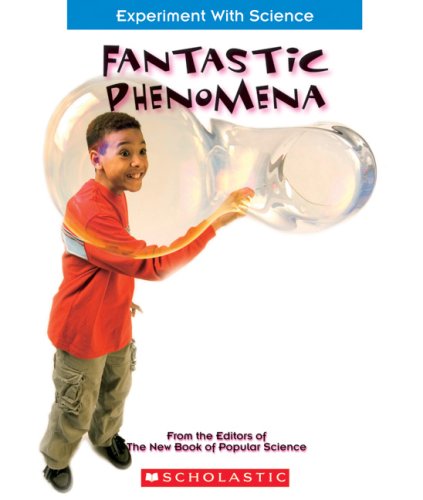-
Experiments in Science: What is it Made of?
David Glover, Linda Martin
Hardcover (DK Children, Sept. 1, 2001)Can you make a bridge out of spaghetti? Why does gelatin wobble? Can you make star-shaped bubbles? Why are windows made of glass? Discover the answers to these questions and more in these fantastic experiments that cover everything from testing which materials are waterproof to making a bubble diver. L
L
-
Experiments With Rocks and Minerals
Salvatore Tocci
Library Binding (Childrens Pr, May 1, 2002)Offers eight experiments to help learn about rocks and minerals, including how they are different, types of rocks and how they are formed, and why minerals are important. N
N
-
A Kid's Book of Experiments With Sound
Robert Gardner
Library Binding (Enslow Pub Inc, Jan. 15, 2016)With clear text and easy-to-find supplies, these experiments invite readers to explore the scientific principles of sound, which include finding out what kinds of matter conduct sound, locating the sources of sound, and matching vibrations. N
N
-
Ecology Experiments
Pamela Walker;Elaine Wood
Hardcover (Facts on File (J), July 1, 2010)Ecology is the study of the relationships between organisms and their living and nonliving environments. This field of science can be divided broadly into two areas: the relationship between an organism and its nonliving environment and the relationship between an organism and other organisms.Ecology Experiments provides students and teachers with the tools they need to explore various ecological issues. The 20 new, hands-on experiments in this book allow students to learn more about this timely scientific field. Filled with vibrant full-color illustrations, as well as an index, glossary, and print and Web resources, this accessible new resource is essential in science classrooms where ecology is part of the lesson plan. Y
Y
-
First Science Experiments: Mighty Machines
Shar Levine, Leslie Johnstone
Paperback (Sterling, Aug. 28, 2006)How do machines work? Kids will have a blast constructing a mini-seesaw to illustrate the way a lever operates or creating their very own pulley from an empty spool, string, ribbon, pails, pennies, a broom, and two chairs. They’ll find out why they can’t put in a screw using only their fingers and examine the different parts of compound machines. In another experiment, a child’s bicycle becomes a laboratory for understanding whether wheels have to be smooth to run. A good time will be had by all. S
S
-
Simple Science Experiments With Marbles
Eiji Orii, Masako Orii, Kaoru Fujishima
Library Binding (Gareth Stevens Pub, Feb. 1, 1989)Presents experiments using marbles to demonstrate what happens when something which is moving hits something else P
P
-
Experiments with Magnets
Salvatore Tocci
Paperback (Childrens Pr, March 1, 2002)Explores the properties of magnets through experiments using equipment readily available in both homes and schools. N
N
-
A Kid's Book of Experiments With Light
Robert Gardner
Library Binding (Enslow Pub Inc, Jan. 15, 2016)With these easy-to-follow experiments, budding scientists will explore the properties of light, including refraction, reflection, and how light travels. Readily accessible materials make this a go-to resource for young readers who want to learn more about light. L
L
-
Science Whiz Experiments Set
Robert Gardner
Library Binding (Enslow Pub Inc, Aug. 15, 2017)None R
R
-
How Hot Is Hot?: Science Projects with Temperature
Robert Gardner
Paperback (Enslow Elementary, Jan. 1, 2015)What is the coolest place in your house? Why should you wear dark-colored clothing if you want to stay warm? Is your body temperature higher on warmer days than on cold days? This book lets you perform lots of fun experiments while learning all about temperature. Using simple materials, you can do everything a scientist does: conduct experiments, keep records, and draw conclusions from what you have learned. You will also get many ideas for follow-up experiments in case you decide to enter a science fair. The colorful illustrations make the book fun and easy to read. Gather up your materials and get ready to learn all about temperature! M
M
-
Chemistry Experiments
Pamela Walker, Elaine Wood
Hardcover (Facts on File, Dec. 1, 2010)Although the first real unifying theory of chemistry was developed in the late 17th and early 18th centuries, the 20th century saw many advances in this field as well. From its Asian and Arabic roots in mystical and spiritual alchemy to the creation of nanochips for computers, the field of chemistry has come a long way in scientific discovery.Presenting 20 new and innovative full-color science projects in a clear, easy-to-understand style, the new Chemistry Experiments gives middle and high school students a firm grasp on this branch of science in a fun, hands-on way. Topics covered include ozone depletion, wood alcohol, heat energy, purifying water, and levels of sugar. M
M
-
Fantastic Phenomena
New Book of Popular Science
Paperback (Childrens Pr, Sept. 1, 2007)Presents ten experiments designed to help students learn about physical phenomena and the scientific method. R
R